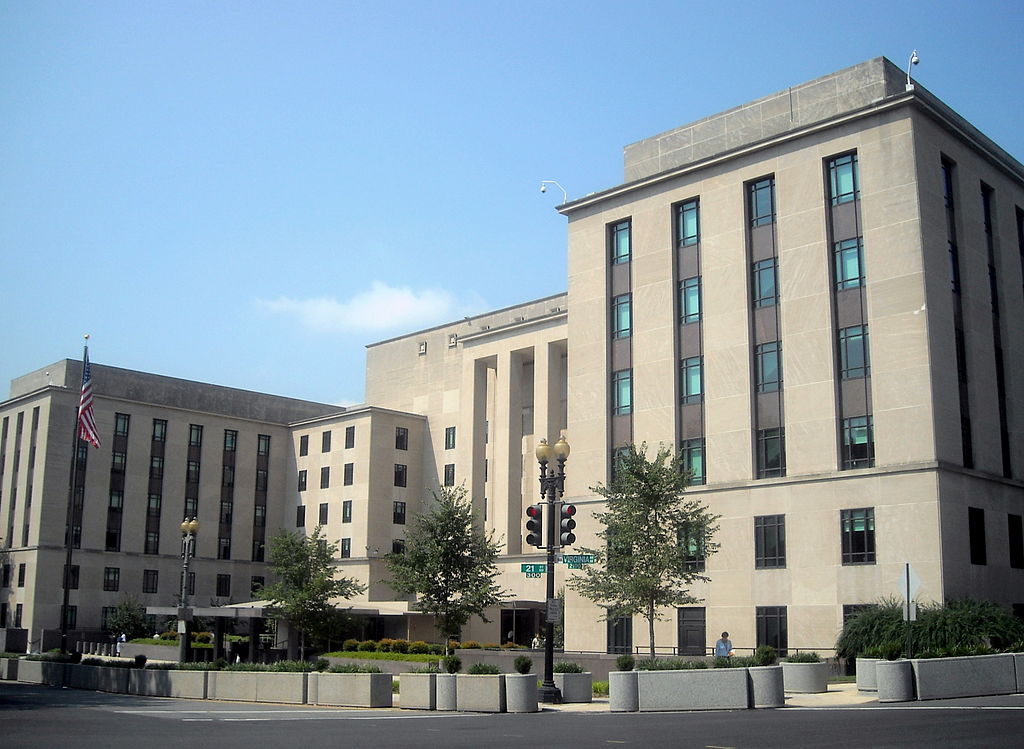Parsing the State Department’s Letter on the Use of Force Against Iran
Recent tensions between the United States and Iran have led many members of Congress to speculate about what legal authority the Trump administration may claim it has to go to war without congressional authorization. On June 28, the State Department gave a partial answer to these questions, at least insofar as they relate to the 2001 and 2002 Authorizations for Use of Military Force (AUMFs).

Published by The Lawfare Institute
in Cooperation With

Recent tensions between the United States and Iran have led many members of Congress to speculate about what legal authority the Trump administration may claim it has to go to war without congressional authorization. On June 28, the State Department gave a partial answer to these questions, at least insofar as they relate to the 2001 and 2002 Authorizations for Use of Military Force (AUMFs). In response to a recent congressional inquiry on the issue, the department wrote:
[T]he Administration has not, to date, interpreted either AUMF as authorizing military force against Iran, except as may be necessary to defend U.S. or partner forces engaged in counterterrorism operations or operations to establish a stable, democratic Iraq.
Some observers have interpreted this statement to mean that the Trump administration is abandoning any effort to rely on the AUMFs to attack Iran. The Hill, for example, described the letter as stating that “with few exceptions, the Trump administration does not believe the 2001 and 2002 war authorizations apply to Iran.” Others read it as a clear sign that the AUMFs may yet play a central role in justifying war with Iran, with House Foreign Affairs Committee Chairman Eliot Engel—whose inquiry the State Department was responding to—arguing that it presents “a loophole wide enough to drive a tanker through.” In reality, neither of these views is correct. Instead, the State Department’s letter says far less about what the Trump administration has planned regarding Iran and the AUMFs than either perspective acknowledges.
The AUMFs addressed in the State Department’s response are statutes that authorize certain U.S. military operations. Congress enacted the 2001 AUMF shortly after the September 11 terrorist attacks to authorize the use of force against the perpetrators of those attacks—al-Qaeda and the Taliban—and their affiliates, though it has since been used (often controversially) as a legal basis for a broad range of overseas U.S. counterterrorism operations. The 2002 AUMF, meanwhile, was adopted in the lead-up to the 2003 invasion of Iraq and authorizes the use of military force to enforce certain Iraq-related U.N. Security Council resolution and defend against “the continuing threat posed by Iraq … .” The executive branch interprets the latter to include military efforts aimed at “helping to establish a stable, democratic Iraq” and “addressing terrorist threats emanating from Iraq[,]” as well as certain efforts to combat terrorist threats against Iraq from nearby states, such as the Islamic State in Syria.
Much of the confusion over the State Department’s June 28 letter appears to hinge on a misunderstanding of when the executive branch “interprets” a given statute. Generally speaking, executive branch lawyers do not have a complete view of how a given statute should be understood. Instead, they withhold judgment until they are asked whether and how a given law applies to a specific set of facts. They then identify various possible interpretations, articulate the legal strengths and weaknesses of each, work with relevant subject matter experts to spell out any policy ramifications, and tee up the issue so that appropriate officials can make an informed decision regarding the executive branch’s position. Executive branch lawyers often have different individual and institutional views about what interpretations are or are not legally available, among other factors, requiring that the issue be resolved by a higher level official. In addition, the resulting interpretations are usually constructed so as to maximize the executive branch’s flexibility in addressing future circumstances. Until a decision is made at the appropriate policy-making level, the executive branch does not have an official interpretation of how a statute applies to a given set of facts. And there often is no reason for the executive branch to reach such a determination—particularly on difficult or controversial questions—unless it must in order to pursue a specific policy.
This is why the words “to date” are central to the State Department’s response. No doubt the department is being honest that the Trump administration has not yet made a determination that the AUMFs could be used to legally justify an attack on Iran. But the Trump administration most likely would not make such a determination unless and until it decided that the use of force against Iran was worth pursuing. It’s significant that the letter does not expressly say that the Trump administration has ruled out relying on the 2001 or 2002 AUMF for future action against Iran. Instead, the State Department is simply saying that the Trump administration has not found it necessary to do so yet in order to justify the policies against Iran that it has already pursued. Whether it will do so in the future is an open question.
For this reason, the State Department’s letter says little about whether the Trump administration might be willing to rely on the 2001 or 2002 AUMF if and when it uses military force against Iran. What it does do, however, is shed light on how the Trump administration has already interpreted and applied the AUMFs in certain prior situations, some of which may have minor ramifications for a potential conflict with Iran.
First, the State Department’s response implies that the Trump administration did not rely on either AUMF as a legal basis for the retaliatory airstrikes against Iran that President Trump recently authorized—and then aborted—for shooting down a U.S. drone. This is not particularly surprising, as such airstrikes fit comfortably within the scope of activities that the executive branch believes the president can pursue under his Article II constitutional authority. Nor would relying on Article II for those initial strikes have precluded the Trump administration from citing the AUMFs as legal authorization for future military action against Iran. For example, when the Obama administration first pursued airstrikes against the Islamic State in Iraq in August 2014, it asserted the authority to do so under Article II. Only later did it claim that airstrikes and other actions against the Islamic State in both Iraq and Syria were also authorized by both the 2001 and, in certain circumstances, 2002 AUMFs.
Second, the State Department says something interesting about how the Trump administration currently interprets both AUMFs. It indicates that the statutes together authorize the use of force where “necessary to defend U.S. or partner forces engaged in counterterrorism operations or operations to establish a stable, democratic Iraq[,]” in a practice that the Defense Department calls “collective self-defense” (emphasis added). But it suggests that this theory might be the subject of broader application than previously known.
For the 2001 AUMF, this is nothing new. The Trump administration has previously told Congress that it views the 2001 AUMF as authorizing this type of collective self-defense. And it has repeatedly relied on this authority to defend local armed groups participating in counter-Islamic State operations in Syria from attacks by the Assad regime and its allies, including through airstrikes on Iran-affiliated forces.
To my knowledge, however, this is the first time the executive branch has publicly extended this collective self-defense theory to the 2002 AUMF. Moreover, the letter implies that the executive branch has most likely relied on this theory to authorize some prior uses of military force, though it’s possible these authorizations were never acted upon. Neither revelation is necessarily surprising: The 2001 and 2002 AUMFs broadly authorize “necessary and appropriate” force—the language that the Trump administration has cited as incorporating collective self-defense to the 2001 AUMF—and Iranian affiliates are believed to have been involved in numerous attacks on U.S. personnel and their Iraqi allies over the past 16 years. Nonetheless, espousing it publicly appears to be a new step.
Under this logic, collective self-defense under the 2001 and 2002 AUMFs might well provide a legal basis for some uses of military force against Iran. But relying on it to start a broader war against Iran would be a dramatic expansion of the theory that the Trump administration has advanced thus far. To date, executive branch officials have described collective self-defense as authorizing the “defen[se] of partner forces from attack or an imminent threat of attack with necessary and appropriate forces” in a manner similar to existing principles of unit self-defense in U.S. military doctrine. “Self-defense is not a deliberate, offensive use of force[,]” the Defense Department reportedly asserted in one response to a congressional inquiry, “[but] a reaction to an attack of imminent threat of attack”—a narrow framing that would be difficult to extend to a large scale, U.S.-initiated military campaign against Iran. This doesn’t mean that the Trump administration couldn’t choose to pursue such a theory. But it does mean that the tension between this new position and the Trump administration’s prior representations to Congress could trigger substantial political costs.
There are many potential legal theories that the Trump administration could rely on to justify the use of force against Iran, several of which I’ve written about previously for Lawfare. Only some involve the AUMFs. Congressional inquiries and other oversight mechanisms are valuable tools for identifying and engaging with these theories—as well as for imposing political costs where the executive branch seems to be considering particularly controversial ones. But they have a limited ability to force the executive branch to develop and express a legal view on a major policy decision it has not yet had to confront. For this reason, statements like the State Department’s June 28 letter are generally best taken at face value as descriptions of prior practice, not indicators of what the executive branch will do in the future.
Editor’s note: This piece has been updated to correct a non-substantive transcription error and a subsequent reference to it.





